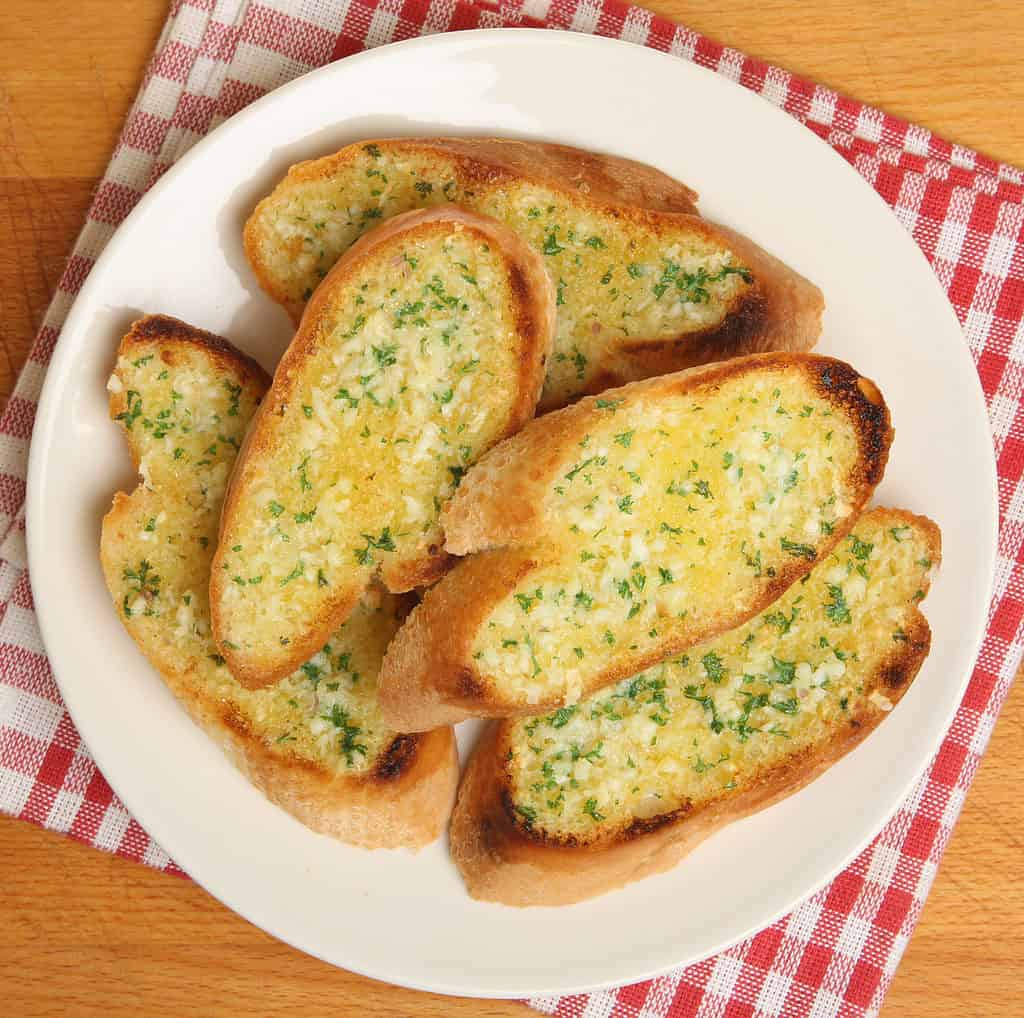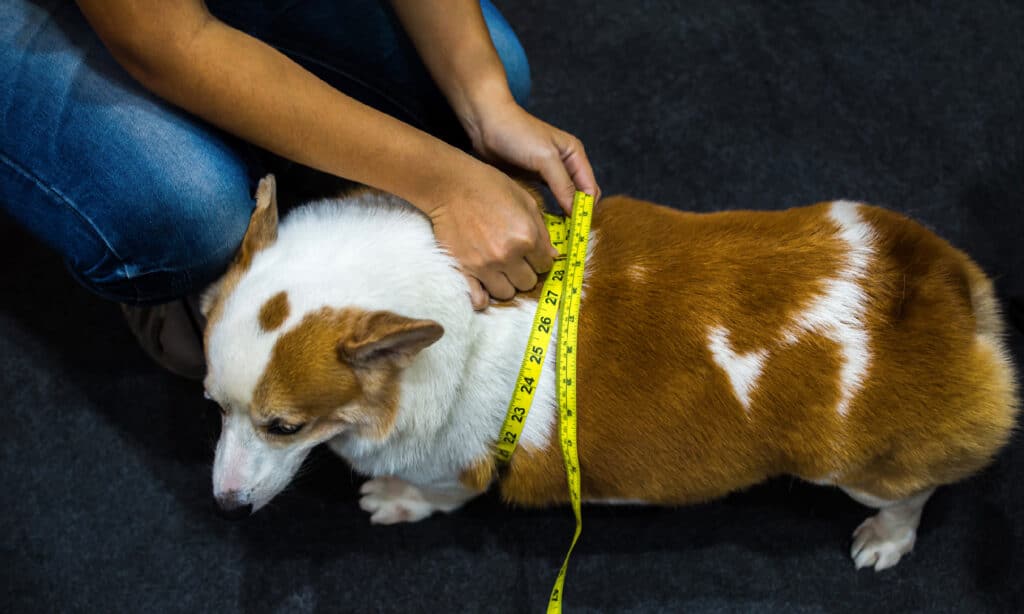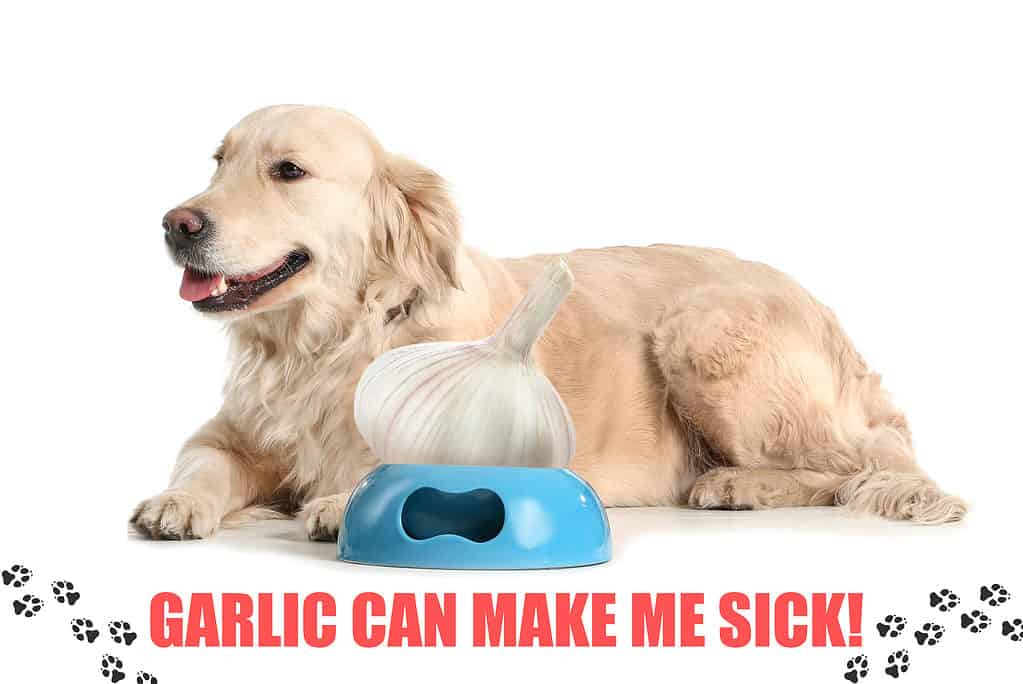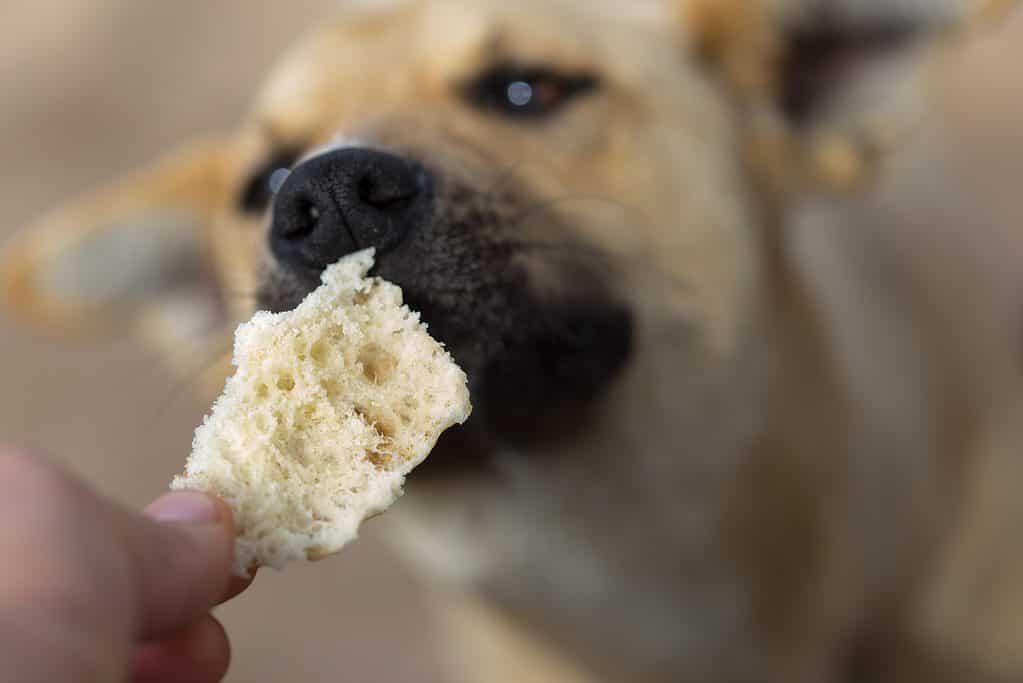↓ Read on to watch this amazing video
Garlic and bread are two food pairings that sound awful on paper, but they actually taste amazing. Lots of people love it as a snack or accompaniment to Italian dishes, but can dogs eat garlic bread too, and what happens if you don’t notice it bites into it?
Garlic is poisonous to dogs, but bread isn’t unless they are wheat or gluten intolerant, so what’s the point? Let’s take a closer look at whether dogs can share garlic bread.
Is Garlic Bread Safe For Dogs?
The quick answer is no. Garlic bread is not safe for dogs.
This is because garlic is poisonous to dogs and can cause serious health problems when used in large quantities. Garlic bread also contains a lot of oil and butter, which has the potential to make our canine friends sick.
Overall, you’re better off eating garlic bread and then giving your dog a healthy snack like thinly sliced bell peppers or apples.
What is Garlic Bread?
This delicious treat is bread, usually a baguette, topped with olive oil and garlic, and baked to a delicious crust (raise your hand if your mouth is watering!). It’s a very simple dish, and some people like to add extra toppings like oregano, chives, or cheese.
Garlic bread has been served in American restaurants since the 1950s and in stores since the 1970s, but it’s a lot more than that. The ancient Greeks, Romans, and Egyptians all had their own versions, and it was a medieval staple, especially in France.
Garlic was also often used as a medicine during these times. Garlic is a potent antiseptic, antiviral and antibacterial agent. It was applied to plague sores in the 1300s and wounds in WWI trenches. Before penicillin was discovered, it was a popular panacea.
But just because it’s good for us doesn’t mean it’s good for Rover. In fact, garlic is poisonous to dogs.

©iStock.com/JoeGough
Health Benefits of Garlic Bread
There are no health benefits, as the risk of garlic poisoning outweighs anything else.
The Risks of Garlic Bread
Let’s start with the garlic issue.
Garlic is in the allium family along with onions, shallots, leeks, chives, and flowering bulbs such as the pretty Purple Sensation allium. All of these are toxic to dogs.
Dogs cannot metabolize garlic.Instead, a method called Thiosulfate Oxidative damage to red blood cells results in hemolytic anemia.
This type of anemia can cause shortness of breath, weakness, pale gums and eyelids, jaundice, dark urine and a range of stomach upsets such as abdominal pain, diarrhea and vomiting.
pancreatitis
The butter and oil on the garlic bread was another problem. There’s no question dogs love hot, buttery foods, but the fat can trigger pancreatitis, a very painful condition in which the pancreas becomes inflamed and releases its digestive enzymes when food is gone. With nothing to do, these enzymes digest the pancreas. Repairs at the vet are painful and expensive. Plus it’s likely to happen again.
obesity
Oil, butter and stale bread lead to obesity. According to the Pet Obesity Prevention Association, 56 percent of dogs in the U.S. are overweight, adding up to about 50 million dogs. Being overweight can limit a dog’s lifespan and make it more likely to develop diabetes, cancer, high blood pressure and mobility problems.

©iStock.com/PongMoji
How Much Garlic Bread Can Dogs Eat?
Dogs shouldn’t be eating garlic bread at all, but studies have shown that 15 to 30 grams of garlic per kilogram of body weight are needed to cause blood changes.
A single bulb of garlic can weigh up to about 7 grams, so your dog would need to eat a lot to get sick. However, garlic can build up over time, and some dogs are more sensitive.
It also depends on the breed of your dog. Large dogs are less affected by a slice of garlic bread than small dogs the size of a chihuahua.
Can Dogs Eat Garlic?
cannot. Dogs cannot eat garlic in any form, even cooked. This includes garlic powder, infused oils, flakes, bulbs, and garlic supplements. Avoid flea supplements that contain garlic unless your veterinarian advises otherwise.

© Pixel-Shot/Shutterstock.com
How about just plain bread?
Yes, dogs can eat bread, but it is best to feed it in moderation and only occasionally.
While bread is high in fiber, carbohydrates, vitamins, and relatively low in sugar, eating it regularly can lead to unhealthy weight gain, which is a real problem for dogs in America. The ASPCA recommends that only 10% of a dog’s daily diet should be treats and 90% a balanced complete dog food. This doesn’t give the bread a lot of leeway.
It is also possible to have an allergy or intolerance to wheat. Wheat intolerance is fairly common in dogs, so manufacturers are introducing new gluten-free dog foods to address the problem.
Signs of a gluten or wheat intolerance are decreased energy levels, poor coat condition, stomach pain, flatulence, diarrhea, vomiting and generalized lethargy. If your dog has gluten or wheat problems, don’t feed them bread.
Just a quick note on the subject of bread!
Raw bread dough is very bad for dogs and can be fatal. This is because the raw bread dough swells to painful levels in the dog’s stomach and releases toxic amounts of ethanol. If your dog bites raw bread dough, consult a veterinarian immediately.

©donikz/Shutterstock.com
My dog ate garlic bread, what should I do?
Don’t panic.
Depending on the size of your dog, a small amount of garlic bread won’t hurt them. We have seen that it takes 15-30 grams of garlic per kilogram of body weight to produce blood changes, and a garlic bulb weighs about 7 grams. They need to eat a lot to get sick.
Monitor your dog for adverse reactions over the next few days and call your veterinarian if you are concerned. Dogs sensitive to garlic may experience stomach upset.
If this happens, give them plenty of fresh water and small amounts of simple food, like turkey and rice or chicken and sweet potatoes, to firm up their poop and stave off that dreaded hunger pang.
Which foods are poisonous to dogs?
In addition to all members of the Allium family (garlic, onions, shallots, chives, leeks, and flowering Allium bulbs), dogs should avoid these foods and drinks:
grapes and raisins
They may seem harmless, but the sweet little grapes and raisins are poisonous to dogs. Grapes cause liver and kidney failure in all their wine, juice, raisin and sultana forms.
Xylitol
This artificial sweetener is found in everything from jelly to juice and low-sugar yogurt. It can cause dramatic drops in blood sugar, even fatal hypoglycemia.
chocolate
Theobromine and caffeine in chocolate are stimulants that can cause organ failure. Chocolate may also contain high levels of fat and toxic xylitol that can cause pancreatitis. It causes vomiting, diarrhea, collapse and coma.
Macadamia
Macadamia nuts are poisonous, even if they’re part of a cake, or your puppy eats just one. The typical symptom is weakness in the hind legs, but lethargy, diarrhea and vomiting are also common.
Alcohol
The ethanol in alcohol can poison dogs and even kill them. Beer, ale, spirits, wine, cocktails and alcoholic sweets Keep puppies away from alcohol as they may be attracted to the sweet taste.
Is Garlic Bread Dangerous For Dogs?
Let’s review our question Can Dogs Eat Garlic Bread? The answer is no, dogs should not eat garlic bread.
While stolen garlic flakes are unlikely to be fatal, regular feeding of garlic to dogs is not recommended as it can cause anemia and the oil can trigger pancreatitis and rapid weight gain.
Occasionally treat Rover to carrot sticks, blueberries or strawberries. Or, if you’re feeling generous and your pooch is in top-notch health, even a cheeky puppypaccino.
next
Ready to discover the top 10 cutest dog breeds in the world?
How about the fastest dogs, the biggest dogs, and those who are – quite frankly – just the kindest dogs on earth? Every day, AZ Animals sends out lists like this to our thousands of email subscribers. The best part? free. Join today by entering your email below.

I am broadly interested in how human activities influence the ability of wildlife to persist in the modified environments that we create.
Specifically, my research investigates how the configuration and composition of landscapes influence the movement and population dynamics of forest birds. Both natural and human-derived fragmenting of habitat can influence where birds settle, how they access the resources they need to survive and reproduce, and these factors in turn affect population demographics. Most recently, I have been studying the ability of individuals to move through and utilize forested areas which have been modified through timber harvest as they seek out resources for the breeding and postfledging phases. As well I am working in collaboration with Parks Canada scientists to examine in the influence of high density moose populations on forest bird communities in Gros Morne National Park. Many of my projects are conducted in collaboration or consultation with representatives of industry and government agencies, seeking to improve the management and sustainability of natural resource extraction.











